This article describes toroidal inductor, its construction, working & applications. Inductors are one of the most critical components in any electrical as well as electronic circuit. One such small but essential component mostly used in a high-frequency electronic device is Toroidal Inductor. Let’s understand its working, design, application, advantages and disadvantages.
Toroidal Inductor Working
A toroidal inductor is nothing but an insulated coil wounded on a small ring-shaped magnetic core also popularly known as Ferrite core. This magnetic core is made up of Ferrite which is a ferrimagnetic material and this core is the most important factor behind the working of the toroidal inductor.
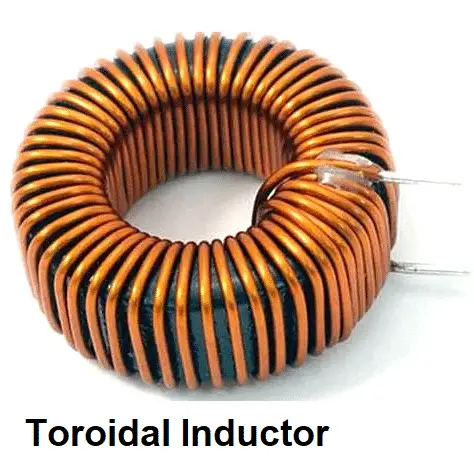
As I said above, toroidal inductors are employed in high-frequency applications. Now, the question comes: why can’t we make use of normal solenoid coils in these applications and what is the advantage that a toroidal inductor has over their solenoid counterparts? Let’s understand.
Any electromagnetic circuit carrying time-varying current has two inherent losses – Hysteresis loss and Eddy current loss.
Hysteresis loss happens due to the constant magnetizing and demagnetizing cycle of the core material. As the current passing through the coil is an alternating one, it causes the core material to magnetize in one direction and then in opposite direction.
Ideally, the core should do this instantly as the current changes its direction but that doesn’t happen. Magnetic cores hold some magnetic flux even if the current goes to zero. Therefore the current has to go through a negative cycle when a portion of this current is required to generate neutralizing magnetic force to bring the residual magnetic field flux to zero. This is therefore accounted as a loss of power called Hysteresis loss. It is given by the equation;
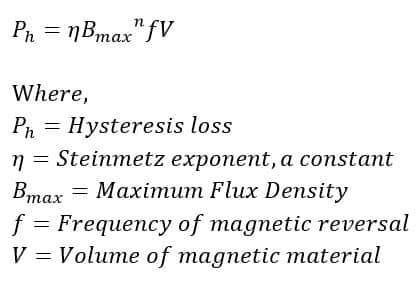
Clearly, we can see that the Hysteresis loss is directly proportional to the frequency of magnetic reversals (f) which depends on the input supply frequency. A normal solenoid core or those which are used in power transformers (Silicon Steel) have a large hysteresis area (B-H curve) as compared to Ferrite cores.
Now as Hysteresis loss depends on Frequency, in high-frequency applications we need a material which has a relatively small B-H curve so that it keeps the Hysteresis loss under control. If a normal core is employed, it will lead to a huge amount of Hysteresis loss. That’s why Ferrite core is used. The picture below shows the B-H curve or Hysteresis curve of both Silicon steel (bigger area) and the Ferrite core(smaller area).
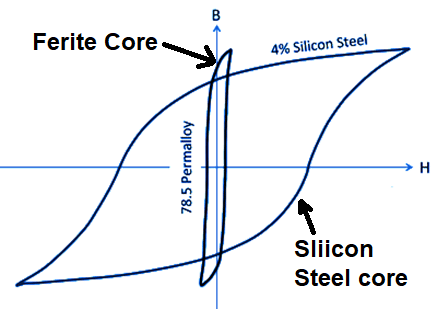
Thus, the Silicon steel core which is used in the case of 50Hz operation if subjected to operation at 100kHz will cause an increase in Hysteresis loss by about 2000 times. That’s why Ferrite core is used.
At the same time, a question may come up that why don’t we make use of these Ferrite cores in case of normal or low-frequency operations? It is because Ferrite is a hard magnetic material which means it holds magnetism permanently or saturates quickly.
Thus, a high-frequency operation is ideal for such material where the core is magnetized and demagnetized at a faster rate, thus leaving no chance of saturation of the core. At low frequencies, the ferrite core will lead to saturation and burnout.
In addition to this, Ferrite has higher resistivity and the core made of Ferrite has higher resistance. Thus, it controls the flow of eddy current naturally and needs no lamination. Eddy currents are generated mainly due to stray magnetic fields which link with the core material and cause the flow of this current through the core material.
Eddy current loss is directly proportional to the square of the frequency of magnetic reversals (f2) and hence it is prudent to make use of a ferrite core for high-frequency operations. All these make ferrite cores ideal for high-frequency electronic circuits.
Toroidal Inductor Construction & Design
A length of copper wire is wounded on a magnetic core material made up of Ferrimagnetic material like Ferrite. Ferrite has higher resistivity and is a brittle material. It has a high coupling coefficient which means the amount of stray magnetic field generated is extremely low.
However, that is the reason why the core is pushed into saturation easily and hence it is ideal only for high-frequency operations. Ferrimagnetism is similar to Ferromagnetism in all aspects of magnetization except the magnetic moment or magnetic ordering. When magnetic moments are paired in the same direction parallel to each other, it is called Ferromagnetism. In the case of Ferrimagnetism, magnetic moments are aligned in unequal numbers in both parallel and antiparallel fashion.
The toroidal inductor magnetic field is calculated by

Where, I is the current through the toroid inductor, r is the average radius of the toroid, N is the number of coil turns per unit length.
Thus by putting the value of I, N and r, we can get the value of magnetic field(B) and therefore the required inductance for our application.
Toroidal Inductor color code
Toroidal inductors used in various applications are of two types – coated and uncoated. The coated cores provide a smoother corner radius as well as a winding surface along with additional edge coverage, edge protection & an insulation function.
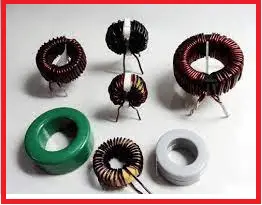
Toroidal cores have coatings like Epoxy Paint and Parylene coating. Epoxy paint is available in different colors like blue, gray & green. Parylene coating is mainly used for little Toroidal core rings that have a low-thickness coating and high dielectric strength.
The coating provides higher insulation thus avoiding a direct short circuit between the winding coil and the core. In addition to that, coating of the core increases its operating temperature as the Epoxy coatings can operate at as high as 200 degree Celsius temperature.
Applications
Like we have discussed before, Ferrite cores are used in inductors where high-frequency operation is there for obvious reasons. Some applications like Inverters, SMPS, amplifiers, radios and televisions make use of ferrite core inductors. In addition to this, ferrite cores are also used to neutralize the effect of Electromagnetic Interference (EMI) in certain high-frequency applications.
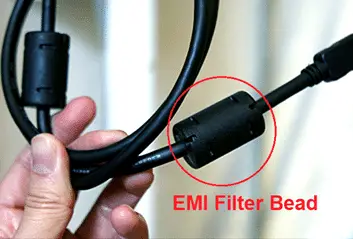
An EMI filter bead is connected in certain electronic circuits which simply traps the stray magnetic field generated and protects sensitive electronic components which may otherwise encounter a fault due to these stray magnetic fields. It also helps in mitigating health hazards that may happen due to high frequency magnetic fields.
Advantages
- Ferrite cores are lighter in weight and smaller in size which makes them ideal for installing on a printed circuit board (PCB) easily.
- Being small in size and having good coupling coefficient, ferrite cores are highly efficient as magnetic circuits carrying the magnetic field with very small stray loss.
- A toroidal inductor is more compact as compared to other shaped cores because they are made with fewer materials.
- Unlike their silicon steel counterparts, ferrite core inductor doesn’t need laminations to reduce eddy currents. This also results in quieter operation.
- Because of less magnetic linkage, there is very small amount of Electromagnetic Interference due to less leakage flux. This is important in case of sensistive electronic components which may otherwise cause sparks and even thermal runaway of these.
- Lower Hysteresis and eddy current losses.
Disadvantages
- Ferrite cores are brittle and any application of greater force while winding coil around them or in any other way may result in the core to dismantle.
- It is difficult to wind coil around this small core using machines.
- Being small in size, it is difficult to gain proper winding insulation as well as magnetic gap. That’s why extra coating is required.
- Ferrite being hard magnetic material may quickly become saturated if the operating frequency or magnetic reversal frequency is not higher than the optimum frequency. Thus, it is more susceptible than other core materials like Silicon Steel.
This is all about toroidal inductors or ferrite core inductors, their working, applications, design, advantages as well as disadvantages. Notwithstanding their disadvantages, toroidal inductors are one of the highly used economical electronic components used in various applications for their robust and reliable performance with desirable results.